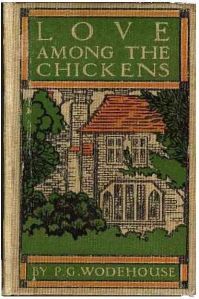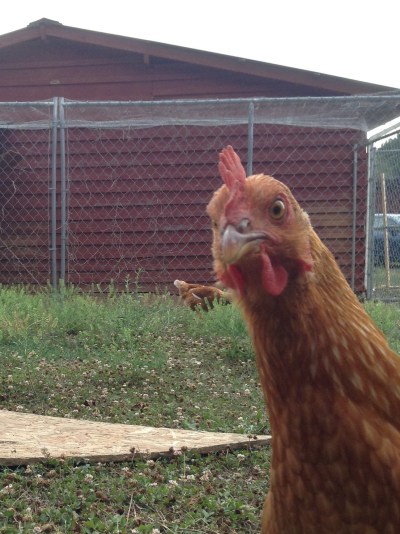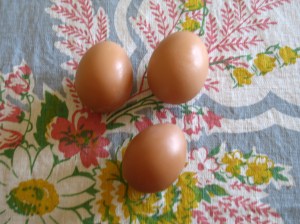I won a trophy! Well, a consolation prize. My sister found it at an antiques mall and presented it to me at Thanksgiving, soon after Ernesto and I went from married, with chickens, to empty nesters.
It was like this:
At the end of the summer we removed the fence around the chicken coop and allowed the hens to roam free. It seemed sensible, since they were able to find ways out of their pen pretty much any time they wanted, and having the fence down made it easier to mow inside the pen. Plus, I loved having the hens out and about, running with the goats or hanging out under the bird feeders. They always went back to the coop to lay eggs and sleep. Life was peaceful and good.
Until Halloween weekend. We went off to work that Friday the owners of two goats and 10 chickens. When we got home on Friday evening, I collected the eggs and noticed that one of the hens was missing. Ernesto said he had spotted a feathery pile across the road and up a bit that morning on his way to the office, and we imagined that some critter had gotten a hen and carried it away. It was a shame, but it does happen from time to time. I didn’t fret about it much.
The next morning we awoke to find that our white goat, Iris, had escaped from the corral and was standing outside the fence, looking as if she very much wanted back in. I went out to open the gate for her and found four chickens dead between the coop and the garden, and two more dead inside the coop. I report that quite calmly, don’t I? At the time, I was not calm. I didn’t scream or faint or anything, but it was a terrible shock, the kind where you walk back and forth and look at the poor limp hens and imagine that in another few seconds they will perk up and live again.
Two hens were actually still alive, though seriously rattled, and another was unaccounted for. I believe that whatever savaged the chickens had spooked poor Iris so badly that she leapt (hard to imagine) out of the corral. She has such stumpy legs, it actually cheered me up to think of her jumping.
We spent a sizable chunk of Saturday afternoon trying to catch the two surviving chickens to put them into the nursery coop, which is smaller and in a high-security pen. It used to be a dog pen, so it has a chain-link fence and the stable forms one wall. When the chickens were young, Ernesto added a layer of chicken wire across the top to discourage attacks from the air. We use it as a halfway point for new chicks. Once they’re sturdy enough to move out from beneath a heat lamp, they live in the nursery pen until they’re old enough to go free-range.
But after surviving the Night of Horror, our last two chickens would not allow us near them. They were Ameracaunas, one of them golden and the other mostly charcoal gray with touches of gold. They may have been shell-shocked, but they were still having nothing to do with us and were much spryer than Ernesto and I. That being the case, I waited for them to go into the coop for the night and then went out and reinforced the little chicken entry door with a heavy piece of wood. (Note: It was actually the sign that Ernesto had made when we had too many eggs to keep. It read “Fresh Eggs” on the first line and “Free Range” on the second line above our phone number. One afternoon a guy called to ask about the free range; he thought we were giving away an oven.)
I also took the wood-and-chicken-wire gate that used to be part of the hens’ enclosure and put that against the heavier piece of wood for extra protection.
Alas, the next morning I found both of those barricades pushed aside, and no sign of the hens. Inside the coop, a terrible struggle had caused the framing of one of the nests to be knocked completely askew. The Ameracaunas evidently fought to the bitter end.
We still don’t know what exactly went after the chickens. Possibly a fox or weasel, maybe even a coyote. Whatever it was, it took the goats several days to get over their uneasiness. The Wednesday after the massacre, Ernesto was working from home and looked up from his computer to see Iris and Rose walking up the driveway side by side. He led them back to the corral with little fuss, but we believe they were patrolling the property to make sure all was well. Either that or they were so psychologically damaged from the things they had witnessed that they were running away from home.
At about the same time that we lost our chickens and (therefore) our source of fresh eggs, I came across a bit of information about St. Swithun. It was almost as if the dear saint were reaching out to give me comfort in my chickenless and (therefore) eggless state:
He was, say the chroniclers, a diligent builder of churches in places where there were none before and a repairer of those that had been destroyed or ruined. He also built a bridge on the east side of the city and, during the work he made a practice of sitting there to watch the workmen, that his presence might stimulate their industry. One of his most edifying miracles is said to have been performed at this bridge where he restored an old woman’s basket of eggs, which the workmen had maliciously broken. – David Nash Ford’s “Early British Kingdoms”
Apparently the egg miracle was St. Swithun’s greatest claim to sainthood, though the diligent building of churches probably didn’t hurt. He also gets credit for the weather during the summer, but I never did understand that part, something about if it’s raining on St. Swithun’s day it will rain for another 40 days. Moving on to more interesting tidbits, I found a charming photo of his skull, which looks rather egg-like itself, all tied up with a crimson ribbon and resting on a red cushion. St. Swithun’s bones seem to have been sent around to several different places, as his skull is in one place while his shins and various other parts are someplace else and possibly not together. Kinda like some of our chickens, poor things. It seems appropriate but sad that he is himself a broken Humpty-Dumpty of a saint, unable to put himself back together again.
Anyway, now we have a participation trophy for chicken farming. I am trying to decide what to have engraved on it, maybe “Remembering the Eggsistential Crisis of 2017,” or “We tried.”
But perhaps leaving it blank is the best memorial to our poor hens.
Remember: May 4 is International Respect for Chickens Day. It’s not too early to plan how you intend to celebrate and/or “protest the bleakness of chickens’ lives.”





